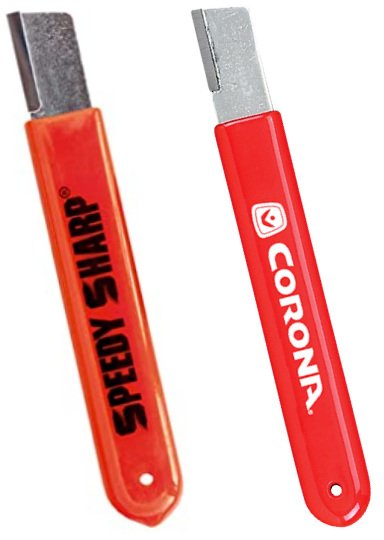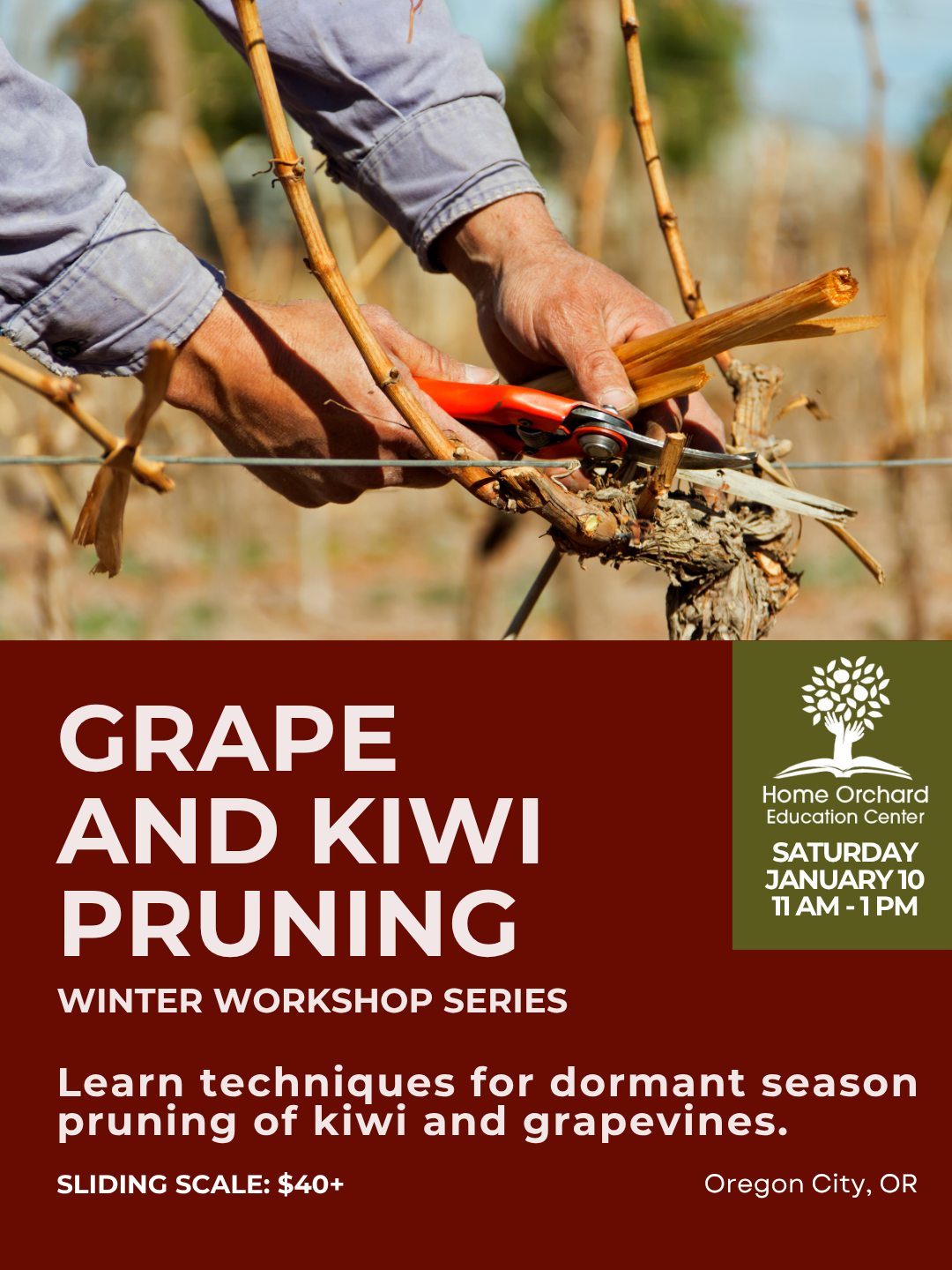An Orchardist’s Tool Kit
ARE YOU NEW TO FRUIT TREE PRUNING AND NOT SURE WHAT TOOLS YOU NEED TO GET STARTED?
You’re not alone! Most incoming Community Orchard Volunteers ask for guidance when it comes to stocking their tool kit. Shopping for pruning gear can be confusing, but we promise it’s simple once you know what you’re looking for. So come along and take a sneak peek into the pruning bags, belts, and buckets of some community pruners at Home Orchard Education Center!
Most experienced pruners have a short list of tools they consider to be “the essentials.” Maybe it’s a brand they favor, a tool they simply could not live without, or perhaps they use grandpa’s old pruning saw exclusively. While every tool kit varies, most will include the same basics, and once you have some experience under your belt you will develop your favorites of your own. Now - let’s demystify these tools and help you set up your own pruning kit.
A NEW ORCHARDIST’S TOOLKIT:
✔️ Bypass Hand Pruning Shears
✔️ Bypass Loppers
✔️ Pruning Saw
✔️ Thinning Snips
✔️ Sharpening Stone
✔️ Spray Bottle With Sanitizer
✔️ Tool Belt & Bucket
So you know, there are NO sponsored products in this post. Just genuine suggestions from local community orchardists.
BYPASS HAND PRUNING SHEARS AKA SECATEURS
Used for: Making precise cuts, on living wood, up to ½” in diameter if you’re being responsible with your tool.
Most farm and garden stores offer a dizzying array of choices when it comes to hand pruners. But look a little closer and you’ll notice that almost all of them will be labeled as either bypass or anvil style. This designation is important. The trees you are pruning are alive, (we hope!) and bypass is the appropriate style to choose when cutting living wood.
Bypass: Has two curved blades that slice by sliding closely past each other like scissors. This style is designed to make clean & precise cuts without crushing delicate living wood.
Anvil: Has one blade on top and a flat metal stop plate on the bottom. This style cuts by slicing from the top while pushing against the bottom plate. Anvil pruners have a tendency to crush when they cut. While we don’t use this style on living plants, they can come in handy if you want to save the blade on your bypass pruners from nicks and dents when cutting dry, brittle, dead wood or chopping up your debris pile.
Each brand will offer slightly different features and will come in varying price ranges. Once you have narrowed your selection by identifying all of the bypass pruners, you will move on to consider the following:
Blade Material: A hard, sharp blade makes a big difference both in ease of pruning, and your ability to make clean cuts that won’t damage your plants. Words like “Professional” or "Heavy Duty" on a label usually signal that the tool has a blade made from high-tempered or hardened carbon steel which will keep a sharpened edge longer. Some also boast a special coating that offers extra protection from rust and sap. Lower quality tools are made of softer stainless steel that will require more frequent sharpening.
Four different sized Felco hand pruners. Bonus if you noticed that one pair is left handed!
Size: Make sure they fit your hand. They shouldn’t be so big that they jump out of your hand when fully extended, or so small that you can’t get a good grip. Some higher end brands like Felco offer multiple sizes, but most will be a one size fits most kind of deal.
Ergonomics: Most styles have solid fixed grips, but a few offer ergonomically supportive rotating handles. These can be helpful if you are prone to wrist or hand pain. People tend to either love or hate these in our experience! Other shears may have cushier molded grips, an angled blade, or other design features made with user comfort in mind.
Replacement Parts: Only some brands offer replacement parts. This may not seem like something to worry about when the tool is brand new, but the ability to replace a spring or blade will be a welcome option after a season or two. If you have the resources, a slightly bigger investment in a higher quality pair of pruning shears with available replacement parts may save you money in the long run.
Blade Adjustments: If you squeeze your pruners closed and hold them up to the sky, you shouldn’t be able to see more than a tiny sliver of light coming through the space between the two blades. Higher quality pruning shears usually have a screw or mechanism that allows you to adjust the tightness of the blades should they come loose.
Locking Mechanism: Most hand pruners will have a locking mechanism to keep them shut when not in use. This is both for your own safety and the safety of the blades. Look for a lock that opens easily and stays closed well. Make sure it doesn’t stick and that it is positioned somewhere that doesn’t get in the way or accidentally flipped while pruning. A lock that can be opened and closed with one hand can be especially helpful when on a ladder. Try out the locking mechanism in your hand before you buy to make sure it feels good to you.
WHAT DO WE USE IN THE HOEC COMMUNITY ORCHARD?
Mid-Range: Our volunteers are supplied with a mid-range hand pruning shear made by Corona with a few miscellaneous Bahco pruners thrown into the mix. The Corona is a sturdy no frills pruner with hardened carbon steel blades, and a basic latch. Nicer than most generic options, they hold up well and are easy to find at your local farm store, but if someone accidentally loses a pair in the debris pile, it’s not the end of the world.
Higher-End: Most of our experienced pruners choose to invest in a slightly higher end pair of hand pruners if they have the means to do so. Felco is a brand you have probably heard of. It is the industry standard and also a crowd favorite here at HOEC. The cutting action is very smooth, the latch is easily closed with your thumb while holding the pruners with the same hand, and all parts are replaceable. You will however hear different folks swear by different brands and there really is no single model that is the “best” to everyone, so just make the best choice you can based on the guidelines above!
BYPASS LOPPERS
Two basic sizes we have stocked in the arboretum. Most of our loppers are made by Bahco.
Used for: Making fairly precise cuts, on living wood that is slightly too large for hand pruners - up to about 2.5” in diameter depending on the size of loppers.
Similar to hand shears, but larger with longer handles, loppers have a bit more reach and leverage for larger branches. Choosing loppers has some similarities choosing hand pruners:
Bypass is the cutting style appropriate for cutting living wood.
Blades made from high-tempered or hardened carbon steel will keep a sharp edge longer.
Only some brands offer replacement parts.
ADDITIONAL CONSIDERATIONS:
Length: Handle lengths range from about 15” to 32”. Most come with fixed length handles, but you may see a few featuring a telescoping handle option. Pros to longer handled loppers are that you may not need a ladder in some cases. Cons are that they are heavier and harder to control, often resulting in less precise cuts.
Bumper Cups: Most nicer loppers have a shock absorbing pad or cushion called a bumper, placed near the blade on the inside of the handles. These are meant to prevent your hands from knocking into each other and take some impact off of your joints when used for longer periods of time.
Cutting Action:
Manual: Most loppers work manually - the cutting power is limited to the strength of the user.
Compound: Some loppers have an additional hinge that provides more power, making it easier to cut through larger branches. This can be a good option for folks who have less strength or those who have a large orchard with many cuts to make.
Ratcheting: As handles are squeezed together, the blades latch in place. Once the blades are locked, you can re-open the handles and tighten them again for increased cutting pressure.
While there are some situations where long handled loppers with built-in cutting assistance are of benefit, if your loppers are too long or heavy for you to make clean cuts with, pull out a ladder and grab a shorter pair of loppers or just use a pruning saw. You might notice that many experienced pruners opt for a lighter pair of loppers with a smaller cutting capacity or turn to a pruning saw to cut anything too large for hand pruners.
WHAT DO WE USE IN THE HOEC COMMUNITY ORCHARD?
Our volunteers are supplied with mid-range loppers made by Bahco, with fixed handles in varying lengths. These hold up well, although we admit we reach for our pruning saws much more frequently than we reach for loppers.
PRUNING SAW
Don’t be afraid to get comfy using a pruning saw! In most cases a sharp pruning saw will make cleaner more precise cuts than a pair of loppers ever will. A saw also has the ability to slide into tight spaces and awkward angles where other tools may not fit. Aside from your bypass hand pruners, this may end up being the tool you turn to the most often.
Confused about which saw to choose? We don’t blame you!
HERE IS WHAT TO LOOK FOR:
Labeled For Pruning Use: When selecting a suitable saw, you’ll want to make sure it is labeled specifically for pruning use.
Pruning specific saws are designed to cut only on the pull stroke which tends to be safer with better control, more power, and less chance of the blade twisting.
A pruning saw also has thinner blades than a typical wood saw, making it better suited for precise cuts without damage to the branch.
Straight vs. Curved Blade: The next potentially baffling choice will be deciding if you should buy a curved or straight blade.
Straight blades are ergonomically designed for use in front of your torso to make cuts that are between the height of your waist and shoulders.
Curved blades are designed for use above your shoulders or lower than your waist.
A curved blade often cuts faster, but a straight blade gives a slightly smoother finish.
In reality, most of us will be pruning trees with branches that are both in front of us as well as above or below us. If you have a limitless budget, you certainly can’t go wrong having both on hand. If you can choose only one however, we would probably recommend the straight blade because it is the most utilitarian of the two and makes the cleanest cut.
Blade Length: Next, you’ll want to choose a blade length that matches the largest branch you anticipate pruning. In the HOEC Community Orchard, we find that a blade in the 6-8” range (not including the handle) covers most of our regular maintenance pruning needs. We do of course also keep larger hand saws and a small chainsaw on on hand because you never know what’s going to happen when you have hundreds of trees to care for!
Folding vs. Non-folding: Another confusing choice for the shopper!
Folding pruning saws are super handy if you want something small and portable that will fit in your tool belt or pocket. They come with blades in a wide range of sizes, from as small as a few inches up to almost two feet long. The smaller saws are excellent for reaching into tiny nooks and crannies. While folding saws are extremely convenient, it does take two hands to close them safely, so that’s something to consider if you spend lots of time on a ladder.
Non-folding saws are sometimes slightly more rigid and require some kind of independent carrying case or scabbard to keep the teeth protected and away from you when not in use. Most professional arborists we know carry a non-folding saw.
Ultimately this may just be a personal choice you make based on what feels the best in your hand and the most suited to your situation.
WHAT DO WE USE IN THE HOEC COMMUNITY ORCHARD?
Personally, I carry a small folding saw in my tool belt, and a larger non-folding saw in my tool bucket. I love that the folding saw is tiny and so easy to shove into whatever pocket is closest when climbing up, down, around, and under.
Affordable Option: Our volunteers are supplied with a small, basic folding saw made by Corona. These are affordable (and were donated to us!) and they are just fine for taking care of most of the basic pruning maintenance.
Higher End: We personally love and use the Silky brand. Our Executive Director swears by the non-folding, straight blade Silky Gomtaro 300, and your author carries a tiny folding Silky Pocket Boy. Silky makes quite a few different versions, as well as extension saws that we also find to be excellent.
THINNING SNIPS
Used for: Making precise cuts on flowers, fruitlets, and small delicate stems.
Thinning snips will be your go-to tool for detailed tasks requiring precision and accuracy. In the arboretum, we use them most for thinning fruitlets and harvesting delicate fruits that require stem cutting (like Asian Pears). Choosing a pair of snips is pretty straightforward. Since they are only used for small delicate cuts, there is not much stress placed on the tool or the blade. As long as your tool is sharp, and your blade hasn’t been bent, you should be good to go.
Curved Vs. Straight Blade: You will see both curved and straight blade options offered and either will work just fine. Your author prefers the curved snips because that curve helps the blade sneak around the edge of fruits to reach the stems very easily.
TOOL BELT & TOOL BUCKET
Over time, your trusty hand tools will become somewhat of a second skin. You will spend many a lovely afternoon together in the trees, taking in the sights and scents of your beautiful fruiting plants. You will love them, make sure they are kept clean and oiled, never accidentally drop them on your toe while climbing your ladder, never leave them behind in a pile of debris, and certainly never run over them multiple times with the lawnmower.
Okay. Fairytale over! In reality, you will accidentally drop and misplace your tools many, many times. You see where we are going with this, right?
A toolbelt or at least a tool holster will make your life much easier, while protecting both you and your trees.
WHAT DO WE USE IN THE HOEC COMMUNITY ORCHARD?
Multi-Use Tool belt: Your author's personal favorite is a heavy duty clip-on tool belt that can hold it all! Inside I keep pruning shears, snips, a small folding silky saw, a sharpening stone, a pair of gloves, and whatever else is needed for the task at hand.
Tool specific scabbards: Maybe you’re more of a minimalist or are working on a project that only requires a pair of hand clippers or a pruning saw. You can usually find scabbards that will clip onto your belt made specifically to hold a single tool or two.
Tool Bucket: For accessories and tools that are too large to fit into your toolbelt, or for folks who don’t like to keep everything attached to them, a five gallon tool bucket with holes drilled in the bottom for drainage is very helpful. You can also use it to collect cuttings, pick up trash, keep a notepad, etc. This may not be necessary for a backyard gardener, but having everything with you can save you lots of back and forth on a larger property.
What’s in your tool bucket today? Mine happened to include cookies, which one might also consider an essential. Don’t forget to drill drain holes!
TOOL SHARPENING STONE
This one is simple! Just throw a couple of “speedy sharps” into your tool belt.
“Speedy sharp” is a brand name, but in the pruning world it usually refers to a small, pocket-sized blade-sharpening stick. You don’t have to buy the Speedy Sharp brand - any similarly styled carbide sharpener will do.
We like this type of sharpener for new and seasoned pruners alike, because it’s super easy to use, fits well into the small opening of your pruning shears, and sharpens quickly. Once you get the hang of it, it’s easy to make a habit of sharpening your tools often, which is better for your plants, tools, and wrists.
SPRAY BOTTLE WITH DISINFECTANT
Best pruning practices warrant that you disinfect your blades any time you move from one plant to another to help prevent the spread of potential disease. At very least, you should be spraying your tools when you move between fruit trees. A small and sturdy spray bottle works well for this task.
We fill our bottles with 70-100% isopropyl alcohol, which is effective against most pathogens, evaporates quickly, and helps dissolve sap on your blades.
If you’d like to learn more about caring for your fruit trees and you live in Clackamas County or the surrounding area, please join us for a hands-on workshop in the HOEC Community Orchard! Our winter pruning series begins in January, and workshops run all twelve months of the year.

























